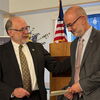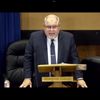High speed ahead: South Portland joins Rockport in upgrading its fiber optic network
Bob O'Brien, one of the owners of the Noyes Hall & Allen Insurance Co. in South Portland, readily admits an insurance company don't necessarily require the kind of bandwidth that the local television production company Lone Wolf Media might need for uploading videos to clients ranging from National Geographic to “Nova.”
Yet, because he also serves on the city's economic development committee, O'Brien says the recent installation of a fiber optic one-gigabit-per-second Internet network in his neighborhood is great news, even if the benefits might prove modest for an insurance company.
“We're definitely looking forward to improved speed and greater reliability,” he says. “I really do see it as an economic development tool. Right now, we're only the second town in Maine to do this. It makes us stand out. It's great that a lot of folks at City Hall thought outside of the box to make this happen.”
One of those out-of-the-box thinkers is Chris Dumais, the city's director of information technology, who credits City Manager James Gailey and former Assistant City Manager Jon Jennings (now Portland's city manager) as key allies in crafting the public-private partnership with Biddeford-based Internet service provider GWI to install up to four miles of fiber optic cable in several central neighborhoods. The new service saves the city about $2,100 a month in operational costs, he says, and gives GWI the opportunity to provide ultra-high-speed Internet service to businesses and residential customers along several corridors of the city.
“It's my baby, I'm the big champion of it,” Dumais says, noting that the gigabit initiative achieved its first milestone with the completion of the $155,000 first phase in May. GWI won the contract for the three-phase project over one competing bidder, Maine Fiber Co.
The first phase establishes a fiber optic connection to Maine's 3-Ring Binder Internet network in the Mill Creek, Knightville Ocean Avenue, Highland Avenue and Evans Avenue corridors. The next phase, Dumais says, is ready to begin and will expand the network farther down Highland Avenue to the new municipal services building. The last phase, whose funding is pending, will connect the James Baka Drive, Western Avenue, Westbrook Street and Wescott Road corridors.
When those three phases are completed, Dumais says, the city will have approximately four miles of fiber optic ultra-high-speed Internet service available to a significant portion of its businesses and residents. Additional expansions are possible, he says, as funding becomes available.
Fletcher Kittredge, GWI's founder and CEO, says the willingness of the South Portland officials to “think like an entrepreneur” was crucial to the successful launch of gigabit Internet service within the city.
“The city is the anchor tenant,” he says, explaining that the first phases will establish one gigabit service to the city's municipal offices and schools. That, in turn, creates a network that easily can be connected to both business and residential customers in those neighborhoods. Unlike the high-speed network GWI built in Rockport, which launched Maine's first municipally owned broadband network last summer, Kittredge says South Portland decided to enter a long-term lease contract with his company to be connected to the high-speed network.
Both projects, as well as municipally driven initiatives to bring high-speed fiber optic Internet service to Islesboro and Sanford, illustrate a kind of do-it-yourself creativity that Kittredge believes is necessary to spur the infrastructure investments needed to significantly improve the speed and quality of Maine's Internet network. His continuing concern, though, is that the state is playing catch-up with literally hundreds of other local governments nationwide that aren't waiting for private Internet service providers to make the necessary investments and are finding unique ways to build their own high-speed networks.
“Unlike much of the rest of the country, we're still trying to sort things out,” Kittredge says, who first sounded the alarm over the state's lagging Internet capabilities in a white paper he published almost a year ago, citing a national study that found Maine's broadband was significantly slower, more expensive and less available than all other states except Montana.
Rocking the status quo
A June 23 article in MIT Technology Review by James Surowiecki credits Google with being the catalyst for spurring state and local governments to install fiber optic lines capable of providing gigabit Internet service, instead of waiting for private ISPs to do it for them. Google disrupted the status quo, Surowiecki writes, when it solicited applications from cities to build new fiber-optic networks in their communities and discovered more than a few were willing to be pioneers. Since rolling out fiber-to-the-home service in Kansas City in the fall of 2012, Google Fiber is now working with 34 cities in nine metro areas across the United States that are eager to achieve ultra-high-speed Internet service.
Surowiecki writes that Google is using its deep pockets to forego short-term gains in order to achieve broad social ends, which directly challenges what he describes as the major Internet companies' tendency to maximize “revenue from their infrastructure rather than upgrading it. “[S]ince Internet service in most cities was supplied by either a near monopoly or a cozy duopoly in which the two players — typically a cable company and a major telecom provider — barely competed against each other, there was little competitive pressure to improve,” he writes. “As long as all the players kept the status quo intact, it seemed, Internet providers could look forward to years of making sizable profits without having to put too much money into their networks.”
Fletcher says Surowiecki's analysis is “spot on” and believes the pioneering examples of Rockport and South Portland will be looked at closely by other Maine towns and cities — and possibly even municipalities in other states.
Open access
Dumais says South Portland's long-term contract with GWI translates into roughly $500,000 in savings over 20 years, largely due to the $2,100 per month leasing fee the city no longer is paying to its former network provider. An important element of the city's partnership with GWI, he adds, is that both parties agreed the new fiber optic network should have “open access” to other service providers. Doing so, he says, should spur competition, leading to lower costs and more choices for local residents and businesses.
After the first phases of the network are completed, he adds, the agreement calls for the city to share in 5% of revenue GWI receives from the business and residential customers it signs up.
“You have to get a lot of customers signed up to get a lot of money coming in,” Dumais says, noting that it's too soon for either the city or GWI to know just how many South Portland residents and businesses will sign up for one gigabit Internet. First and foremost, he says, the city's interest has been to greatly improve Internet service for its schools and municipal offices, with the added benefit being that it leverages GWI's access to potential new customers within the neighborhoods that will be connected by the four miles of initial fiber optic cable being installed.
Asked if the city eventually would expand the fiber optic network through its entire geographic footprint, Dumais replies: “That's tough. Would I like to do it? Absolutely. Is it feasible? I'm not sure yet. We don't want to raise our taxes in order to accomplish it.”
The most likely path for expansion, Dumais says, will involve identifying clusters of residential or large-scale business customers who want gigabit Internet service and are sufficient enough in their numbers to generate the revenue needed to justify the build-out costs.
A shift in the wind?
Kittredge regards the South Portland project as a shining example of how “nimble, cost-effective and creative solutions are possible when your goal is to provide world-class Internet service.”
Elsewhere in Maine, he's encouraged that Islesboro voters approved at their May 30 town meeting $206,830 in funding for engineering, site development and other related costs as the essential first step in having GWI install a fiber optic gigabit Internet network on the island of 600 year-round residents. The plan is to have that work completed in time for another town meeting later this year to approve a municipal bond in the range of $2.5 million to $3 million to fund the project.
The Portland-based technology company Tilson, which did the feasibility study for the Islesboro project, is exploring the feasibility of expanding Rockport's gigabit network into the neighboring city of Rockland.
It also was hired to do a feasibility study for Sanford, which Kittredge says faces the particular problem of having to connect to the 3 Ring Binder in order to be able to create a network that would serve the greatest number of customers. Tilson's maximum build-out scenario, which connects all the key community anchor institutions in Sanford, envisions the project would spur economic development adding “between $47 and $192 million to the Sanford-Springvale region's economic output over the next 10 years.”
The statewide challenge, Kittredge says, involves finding the political will and capital to invest the estimated $1.1 billion to $1.65 billion needed to build a fiber optic gigabit network covering the entire state. Maine's relatively low population density and challenging geography make it a money-losing scenario for Internet service providers to build out fiber networks on their own in all but the most urban areas.
“There is not going to be a white knight riding in to take care of us,” he says. “So it's going to take lots of different solutions, lots of different models.”












Comments